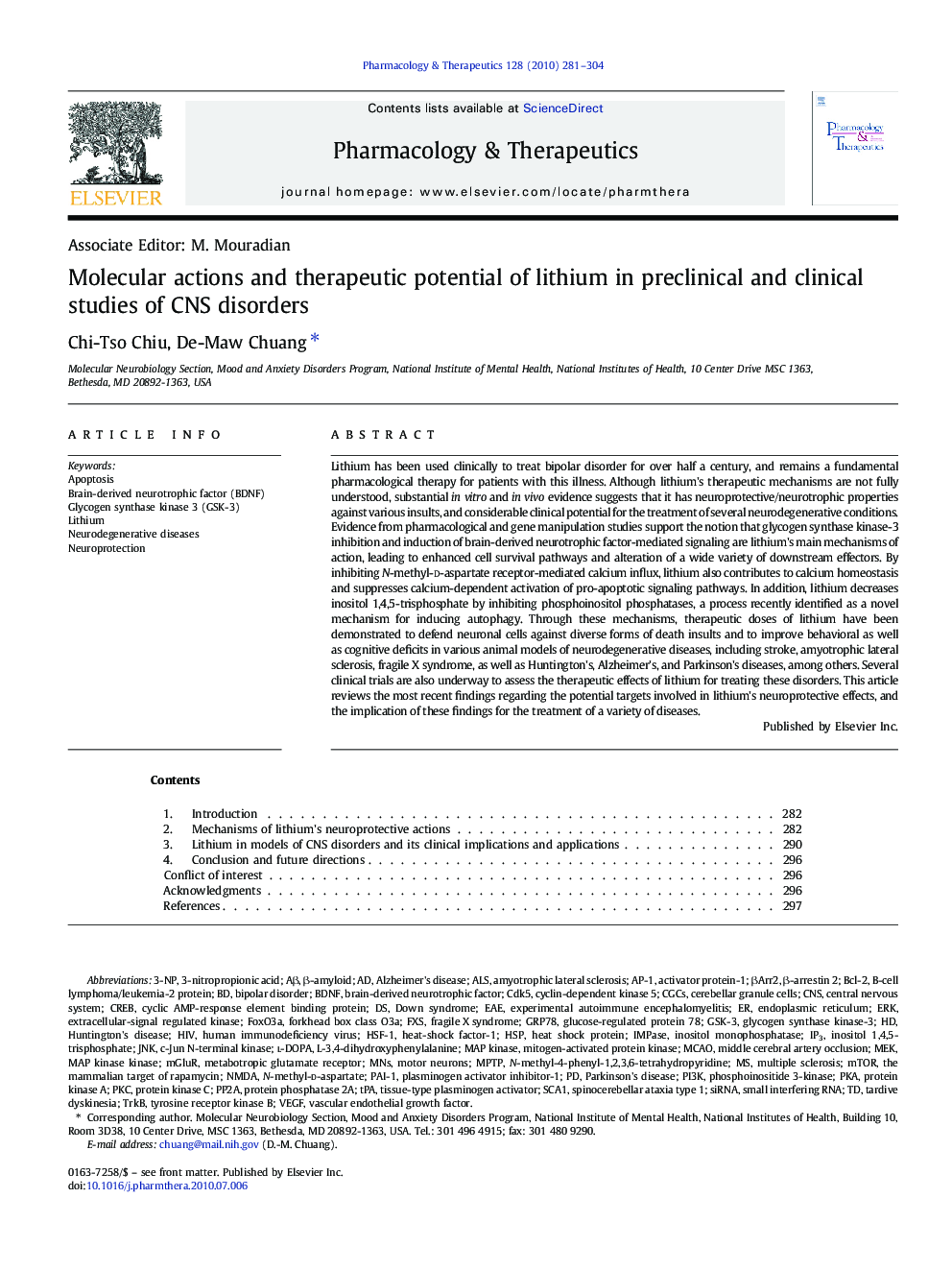| Article ID | Journal | Published Year | Pages | File Type |
|---|---|---|---|---|
| 2563763 | Pharmacology & Therapeutics | 2010 | 24 Pages |
Abstract
Lithium has been used clinically to treat bipolar disorder for over half a century, and remains a fundamental pharmacological therapy for patients with this illness. Although lithium's therapeutic mechanisms are not fully understood, substantial in vitro and in vivo evidence suggests that it has neuroprotective/neurotrophic properties against various insults, and considerable clinical potential for the treatment of several neurodegenerative conditions. Evidence from pharmacological and gene manipulation studies support the notion that glycogen synthase kinase-3 inhibition and induction of brain-derived neurotrophic factor-mediated signaling are lithium's main mechanisms of action, leading to enhanced cell survival pathways and alteration of a wide variety of downstream effectors. By inhibiting N-methyl-d-aspartate receptor-mediated calcium influx, lithium also contributes to calcium homeostasis and suppresses calcium-dependent activation of pro-apoptotic signaling pathways. In addition, lithium decreases inositol 1,4,5-trisphosphate by inhibiting phosphoinositol phosphatases, a process recently identified as a novel mechanism for inducing autophagy. Through these mechanisms, therapeutic doses of lithium have been demonstrated to defend neuronal cells against diverse forms of death insults and to improve behavioral as well as cognitive deficits in various animal models of neurodegenerative diseases, including stroke, amyotrophic lateral sclerosis, fragile X syndrome, as well as Huntington's, Alzheimer's, and Parkinson's diseases, among others. Several clinical trials are also underway to assess the therapeutic effects of lithium for treating these disorders. This article reviews the most recent findings regarding the potential targets involved in lithium's neuroprotective effects, and the implication of these findings for the treatment of a variety of diseases.
Keywords
HspmTORPAI-1cdk5cyclic AMP-response element binding proteinBcl-2ERKPP2AHeat-shock factor-1AP-1HSF-1AβpKaMCAOEAECREBIP3MPTPβ-Arrestin 2NMDAN-methyl-d-aspartateFOXO3a3-NPMNsSCA1PI3KGSK-3JnkIMPaseInositol monophosphatasemGluRFXSPKCCGCsGRP78tPAMAP kinase kinaseTrkBLithium3-nitropropionic acidBDNFc-Jun N-terminal kinaseinositol 1,4,5-trisphosphatel-3,4-dihydroxyphenylalaninel-DOPAN-methyl-4-phenyl-1,2,3,6-tetrahydropyridineSmall interfering RNAsiRNAβ-Amyloidexperimental autoimmune encephalomyelitisbipolar disorderamyotrophic lateral sclerosismiddle cerebral artery occlusionAlzheimer's diseaseALSHuntington's diseaseNeurodegenerative diseasesParkinson's diseaseApoptosisCNSTardive dyskinesiacerebellar granule cellsDown syndromecentral nervous systemcyclin-dependent kinase 5extracellular-signal regulated kinaseendoplasmic reticulumVascular endothelial growth factorVascular Endothelial Growth Factor (VEGF)Brain-derived neurotrophic factor (BDNF)Brain-derived neurotrophic factorphosphoinositide 3-kinaseTissue-type plasminogen activatorMEKNeuroprotectionPlasminogen activator inhibitor-1Multiple sclerosismotor neuronsspinocerebellar ataxia type 1the mammalian target of rapamycinhuman immunodeficiency virusHIVglucose-regulated protein 78Heat shock proteinprotein phosphatase 2Aactivator protein-1protein kinase AProtein kinase Cmitogen-activated protein kinaseMAP kinaseglycogen synthase kinase-3tyrosine receptor kinase BMetabotropic glutamate receptor
Related Topics
Health Sciences
Pharmacology, Toxicology and Pharmaceutical Science
Pharmacology
Authors
Chi-Tso Chiu, De-Maw Chuang,
